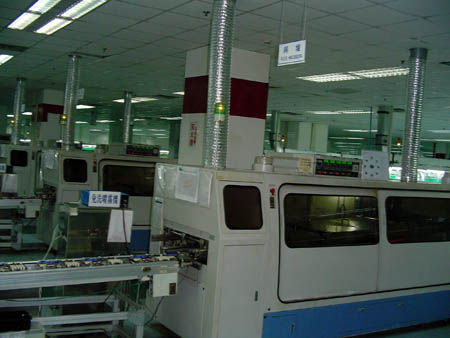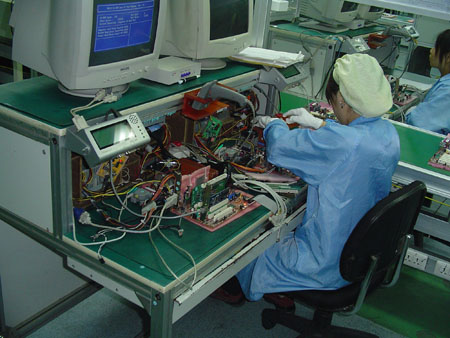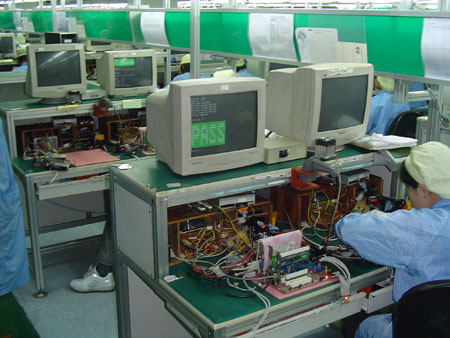The Birth of an Abit NF7 - A Factory Tour
by Kristopher Kubicki on June 11, 2004 10:12 PM EST- Posted in
- Motherboards
Solder
After going through the assembly line, the components just placed on the motherboard are only tacted in place. In order for their transformation to be complete, they must go through an industrial oven so the solder bonds correctly to the board. This is actually the second oven on the production line; the first is used right after SMT.This is actually not an ordinary oven, its a wave solder machine. Wave solder ovens run the motherboard over a molten solder bath in order to melt the fastened components onto the board. You can see a small clip below of the motherboard passing through a final phase in the device. There are two other wave solder machines at Rolly that are completely lead free. Lead free machines use similar assembly techniques, but the solder does not contain any lead (EU legislation requires all electronics imported into the union to be lead-free by 2005). The ovens on those two lines run at different temperatures and look slightly different.
After the oven, a few workers spot solder larger components, which need a little extra to hold in place. Heatsinks and stickers are also placed on the motherboard. Everything else from this point until packaging is quality assurance.
Just like the ECS Shen Zhen facility, each motherboard is completely assembled and booted up to make sure it passes the first stage of quality control. Several custom benchmarks are run, and the system stays on for about two minutes. Each worker works on two motherboards at a time, assembling one while the other is running system diagnostics. It takes less than a minute for each worker to build the entire system.
These boards are only tested once. The workers here will bin bad motherboards into a container, which goes back to the original lab with the oscilliscopes. Good motherboards continue down the line, get scanned into the Oracle database, and are then stamped "OK" to continue on to stress testing or packaging.
However, these motherboards are still not done yet. Out of each batch of 1000 motherboards, 32 are chosen randomly for environmental stress testing, plus a 168-hour burn in. A majority of the other 968 motherboards in the batch are placed into a different testing facility where they will be burned in for 24 hours. Burn in is simply the process of running a benchmark software on the system continuously for an allocated amount of time. Additionally, 10 other motherboards per model per day are selected off the final assembly line and are fully hand-assembled into a PC. Several lucky workers spend the rest of the day making sure UT2K4 (among other software) works correctly with the sampled motherboard.














19 Comments
View All Comments
fengpc - Sunday, August 22, 2004 - link
Visited Suzhou two times, it's a nicer area than ShenZhen IMO. The industry zones look cleaner and more organized. However I believe they will have power issues just like other mfg zones in China soon. Nice article, enjoy reading it.KristopherKubicki - Wednesday, June 16, 2004 - link
http://images.anandtech.com/reviews/motherboards/a...Kristopher
Glenngalata - Wednesday, June 16, 2004 - link
An excellent overview of what is involved in the motherboard manufacturing world.The key point to this article is the availability of cheap labor. There would never be a way to produce an American made motherboard product that would be cost effective against the the far east produced items which is unfortunate.
Another key point to the article is the comment of the ABIT quality control being obviously tighter than that of ECS. Anyone who has owned an ECS product can attest to the fact that the lemon rate for their products distinctly shows the quality difference going against ECS. They may be a larger company but they did not get there by catering to buyers who care about any level of satisfaction. Maybe this is why ECS was voted one of the worst quality control entities in the entire motherboard segment.
The choice is yours but ABIT scored my vote on this one.
MadAd - Wednesday, June 16, 2004 - link
yeah please, whats the url?KristopherKubicki - Tuesday, June 15, 2004 - link
14: I have it - its 23MB though. send me an email, i will drop it somewhere you can pick it up.Kristopher
manzana - Tuesday, June 15, 2004 - link
Interesting article. Wish there was a video of that person building the pc within 1 minute ;)araczynski - Monday, June 14, 2004 - link
very nice article, makes me miss my days in the industrial automation field, but not the pressures :)KristopherKubicki - Monday, June 14, 2004 - link
Jaramin,Like i said in the ECS article also, workers work about 8 to 9 hours a day and are provided with meals/housing. There is very little variation between any company that operates out of China; its kind of all about standardized. If you have any other specific political or economic questions feel free to ask.
Kristopher
Jaramin - Monday, June 14, 2004 - link
It would be nice if some more information about the ethical or human ressource aspect of the manufacture would be included. The only thing that was provided here is that the workers are paid 100$/month...Some of us like to know what is the actual human cost of a product. Knowing that company A offers better working conditions than B could certainly weight on my choice of boards.
ViRGE - Monday, June 14, 2004 - link
While I don't really have anything of substance to say, I would like to say that this is one of those "wow, that's cool" kind of articles that are always great to see. Kudos for doing these kinds of things, guys.